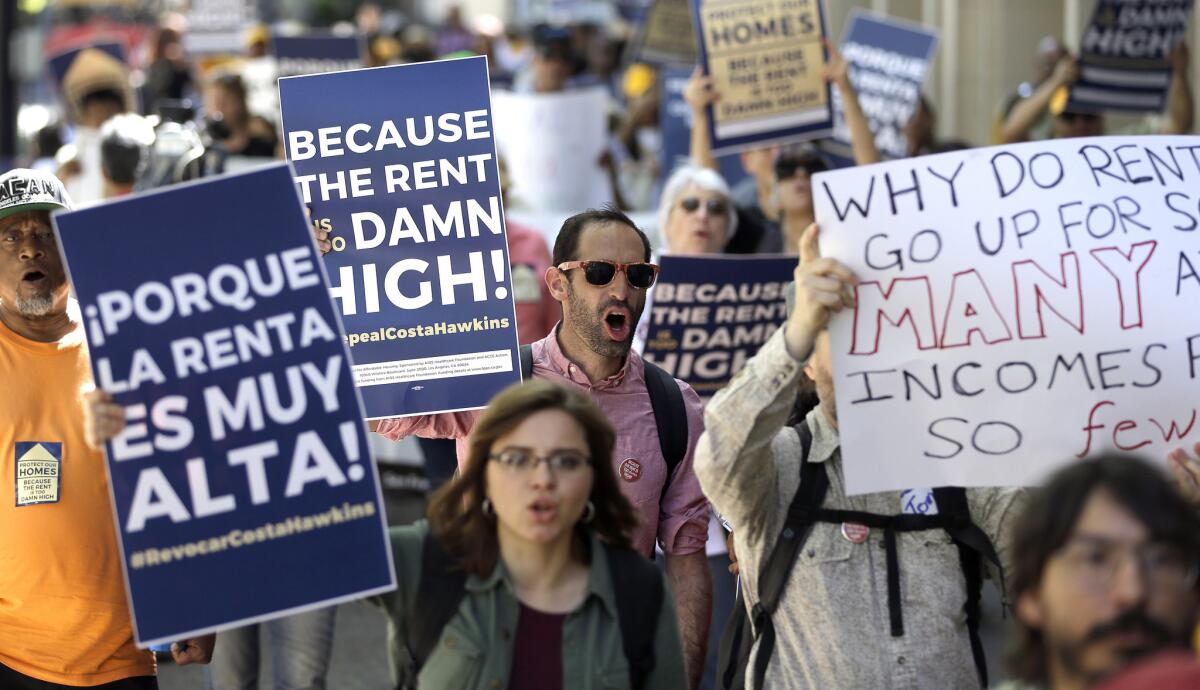Californians will make a big decision on rent control in November

- Share via
Reporting from Sacramento — California voters will decide in November whether to give cities and counties new freedom to expand the use of rent control after an initiative backed by tenant groups earned a spot Friday on this fall’s ballot.
The initiative would repeal a decades-old state law that prevents local governments from passing most new rent control laws.
For the record:
12:00 a.m. June 16, 2018This article originally identified Goodmon as the director of the AIDS Healthcare Foundation. He is the director of the foundation’s rent control campaign.
Supporters, who collected at least 407,769 signatures to put the measure before voters on Nov. 6, said its success was a reflection of a widespread affordable housing problem.
“It recognizes that millions of California residents are struggling to afford their homes and can’t wait any longer for relief,” said Damien Goodmon, the campaign’s director for the AIDS Healthcare Foundation, the proponent of the initiative.
Supporters have also pointed out the Legislature still has an opportunity to act on its own to expand rent control and have the measure withdrawn from the November ballot. But lawmakers have not been able to find an alternative that satisfies both sides in the debate.
Coverage of California politics »
The campaign is expected to be one of the highest profile and expensive in California this year. Opponents such as California Apartment Assn., which represents landlords, has estimated it will spend upwards of $60 million to defeat the initiative, and is already running social media campaigns against it.
The measure’s most vocal opponents didn’t immediately respond to Friday’s announcement.
The rent control battle comes as California continues to face a housing affordability crisis. Six of the nation’s 11 most expensive rental markets are in the state, and rents have increased 40% across the Bay Area in the last three years, according to a January report from the nonpartisan Public Policy Institute of California. Median rent for a two-bedroom apartment is $1,798 in Los Angeles and $3,377 in San Francisco, the report found.
These prices affect low-income residents the most: 1.7 million California families pay more than half their income on rent, according to the state housing department.
Rent control, tenants’ groups argue, is necessary to insulate people from price hikes and allow them to stay in their neighborhoods. But economists, including liberal ones, contend that rent control leads to decreases in home building, and housing shortages are a key driver of California’s affordability problem.
Fifteen cities across the state have some form of rent control. Los Angeles’ program is limited to apartment buildings built before October 1978, and city leaders aren’t allowed to change it. That’s because of a state law known as the Costa-Hawkins Rental Housing Act, which prohibits local governments from implementing rent control on buildings constructed after 1995. The law also froze existing rent control laws in cities like Los Angeles and San Francisco. Costa-Hawkins also blocks cities from putting rent control rules on single-family homes and allows landlords to charge market rate after a rent-controlled tenant moves out.
Though the November ballot measure would repeal Costa-Hawkins, new rent control policies would not automatically go into effect. Rather, the repeal would allow cities and counties to pass additional rent control measures.
The initiative has divided prominent Democrats. Los Angeles Mayor Eric Garcetti has endorsed the effort, saying it’s unfair that rent control doesn’t cover tenants in newer buildings. But Lt. Gov. Gavin Newsom, the leading gubernatorial candidate, opposes it. He wants to increase protections for renters but argues a Costa-Hawkins repeal is too aggressive. Newsom’s challenger in November, Republican businessman John Cox, also opposes it.
Garcetti says he would consider expanding rent control in L.A. »
In January, legislation to repeal Costa-Hawkins failed to advance out of an Assembly committee after hours of heated testimony from struggling renters and landlords worried about their investments. Two Democrats on the committee, Assemblymen Ed Chau of Arcadia and Jim Wood of Healdsburg, did not vote for it, citing concerns about possible slowed housing construction.
By that point, however, the initiative campaign was already underway. The primary financial backer of the measure is the Los Angeles-based AIDS Healthcare Foundation, which has so far contributed $1.6 million to the campaign. The organization, which argues its focus on housing benefits the low-income AIDS patients it serves, is a veteran of recent state and local ballot measures. Two years ago, the group raised nearly $20 million in a losing effort aimed at lowering prescription drug prices in California.
Landlord groups have offered a number of concessions in an effort to stave off the initiative. An apartment association representative said the organization could accept rent control on more recently built properties. The group also endorsed a proposal from researchers at UC Berkeley as an alternative to repealing Costa-Hawkins. The researchers suggested statewide annual rent caps on inflation plus 5%, alongside property tax breaks for landlords who convert their apartments to those serving low-income residents.
But tenant organizations say those efforts do not go nearly far enough, especially as bills that would increase benefits for tenants continue to be easily defeated in the Legislature.
Time is running short for a compromise. Backers say they have no intention of pulling back on the initiative and state elections officials formally certify November ballot initiatives on June 28.
UPDATES:
7:50 p.m.: This article was updated with reaction from supporters.
This article was originally published at 6:20 p.m.
More to Read
Get the L.A. Times Politics newsletter
Deeply reported insights into legislation, politics and policy from Sacramento, Washington and beyond. In your inbox three times per week.
You may occasionally receive promotional content from the Los Angeles Times.











